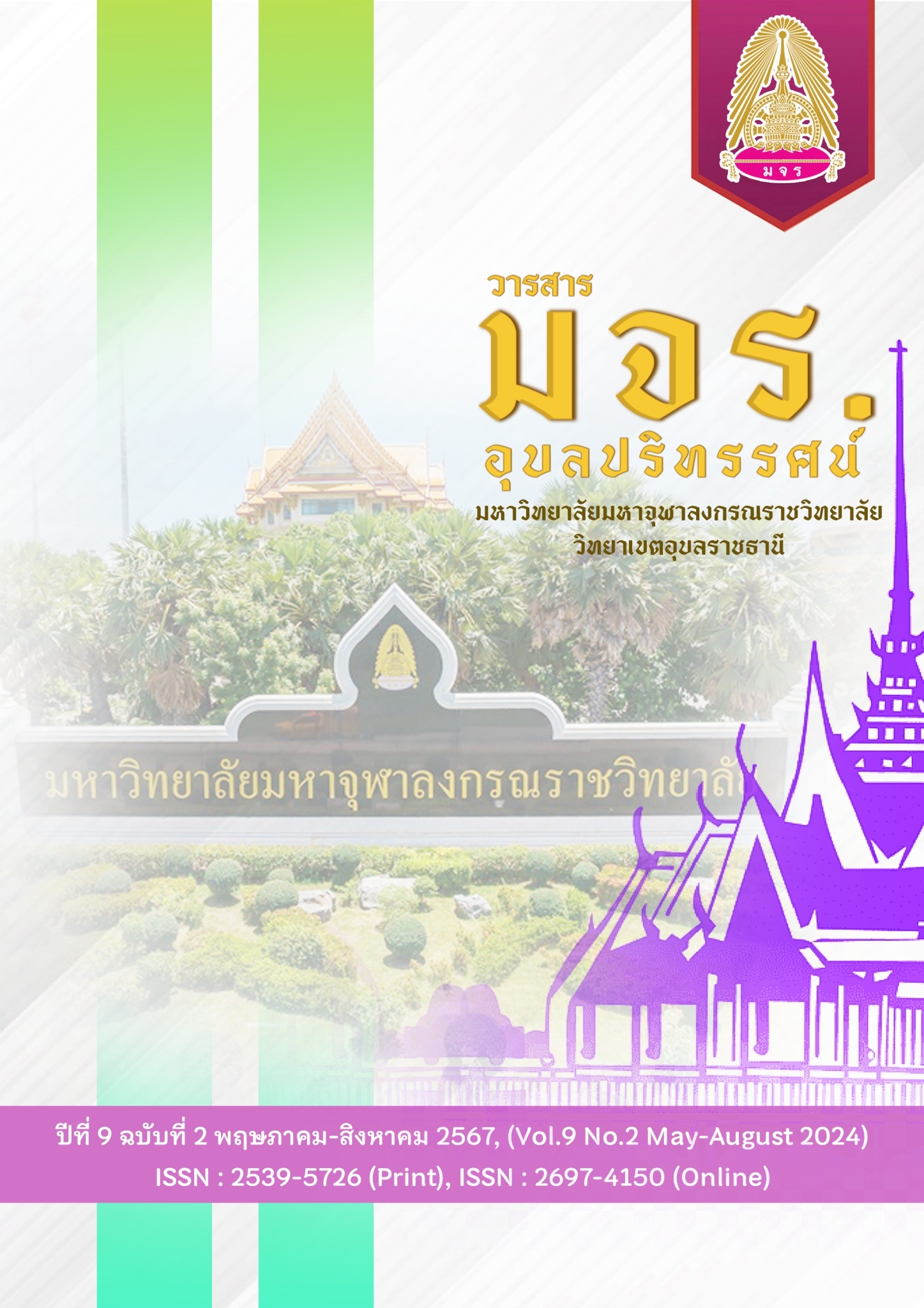PROBLEMS AND NEEDS FOR DEVELOPING THAI LANGUAGE TEACHERS’ COLLECTIVE TEACHER EFFICACY: A CASE STUDY OF AN INTERNATIONAL SCHOOL
Main Article Content
Abstract
This research aims to examine the challenges and needs associated with developing the process for enhancing collective teacher efficacy among Thai language teachers at an International School. Employing qualitative research methods and a case study approach, this study focuses on Berkeley International School, using purposive sampling to select one administrator and four Thai language teachers as participants. Data sources included personnel, documents, and observations. Research tools comprised semi-structured interviews for in-depth data collection and content analysis to analyze and categorize findings from documents and observations.
The research findings suggest the need to address several key developmental areas based on the concept of collective teacher efficacy: 1) Empowered Teachers: Thai language teachers require increased decision-making power in managing the Thai language curriculum, emphasizing the need for their participation and opinion in scheduling and curriculum decisions. 2) Embedded Reflective Practices: There is a lack of adequate feedback mechanisms for Thai language teachers, highlighting the necessity for a formal and continuous system of observation. 3) Cohesive Teacher Knowledge: Teachers employ diverse instructional techniques, with no consensus on the most effective methods. 4) Goal Consensus: There is a lack of clear goal-setting and communication of these objectives among Thai language teachers at the school. 5) Supportive Leadership: While teachers are entrusted with instructional management, they seek more supportive guidance and expertise from administrators familiar with Thai language pedagogy.
Article Details
References
จรินทร์ วินทะไชย์. (2564). ผลการพัฒนาชุมชนแห่งการเรียนรู้ทางวิชาชีพที่มีต่อการรับรู้ความสามารถของตนเองและการรับรู้ความสามารถของกลุ่มครู: กรณีศึกษาโรงเรียนปทุมราชวงศา จ.อำนาจเจริญ: โครงการวิจัย.
ทิศนา แขมมณี. (2557). ศาสตร์การสอน : องค์ความรู้เพื่อการจัดกระบวนการเรียนรู้ที่มี ประสิทธิภาพ. กรุงเทพฯ: ด่านสุทธาการพิมพ์.
ฐะปะนีย์ นาครทรรพ. (2545). การสอนภาษาไทย. กรุงเทพฯ: ศูนย์ส่งเสริมวิชาการ.
สมาน นาวาสิทธิ์. (2554). รูปแบบความสัมพันธ์โครงสร้างเชิงเส้นของปัจจัยที่มีอิทธิพลต่อความสำเร็จทางวิชาการของผู้เรียนในโรงเรียนสังกัดสำนักงานเขตพื้นที่การศึกษาในภาคตะวันออกเฉียงเหนือ.http://backoffice.thaiedresearch.org/uploads/paper/7a34fb18ca13087a4e1d7e443cbd4888.pdf
สืบสกุล นรินทรางกูร ณ อยุธยา. (2564). การบริหารทรัพยากรมนุษย์ทางการศึกษาแนวใหม่. สำนักพิมพ์จุฬาลงกรณ์มหาวิทยาลัย.
สำนักงานคณะกรรมการส่งเสริมการศึกษาเอกชน. (2560). แผนพัฒนาการศึกษาเอกชน พ.ศ. 2560-2564. https://opec.go.th/uploads/2023/plan/20230105_144543_837_3-1.pdf
สำนักงานคณะกรรมการส่งเสริมการศึกษาเอกชน. (2566ก). แผนปฏิบัติราชการประจำปีงบประ มาณ 2566. https://drive.google.com/file/d/1t2Ue- 691gclKRHGreZUcdDXrp7dkLfmg/view
สำนักงานคณะกรรมการส่งเสริมการศึกษาเอกชน. (2566ข). หลักสูตรวิชาภาษาไทย วัฒนธรรมไทย และประวัติศาสตร์ไทยสำหรับโรงเรียนในระบบประเภทนานาชาติ. https://opec.go.th/uploads/2023/download/20230110_102352_797_SCAN_c ompressed.pdf
เสาวรส ยิ่งวรรณะ. (2555). บทบาทของความเชื่อประสิทธิภาพรวมกลุ่มและในตนที่เป็นตัวแปร ส่งผ่านระหว่างภาวะผู้นำการเปลี่ยนแปลงกับความผูกพันต่อองค์การของครู: การ วิเคราะห์โมเดลสมการโครงสร้างพหุระดับจุฬาลงกรณ์มหาวิทยาลัย. [วิทยานิพนธ์ดุษฎี บัณฑิต]. Chulalongkorn University Intellectual Repository (CUIR). https://cuir.car.chula.ac.th/handle/123456789/39530
Anderson, C. M., Summers, K. H., Kopatich, R. D., & Dwyer, W. B. (2023). Collective Teacher Efficacy and Its Enabling Conditions: A Proposed Framework for Influencing Collective Efficacy in Schools. AERA Open, 9, 23328584231175060. https://doi.org/10.1177/23328584231175060
Bandura, A. (1997). Self-efficacy: The exercise of control. New York, NY: W.H. Freeman and Company. Dessler, G. (2013). Human resource management (13th ed.). Boston, MA: Pearson.
DeWitt, P. (2020). How Collective Teacher Efficacy Develops. Educational Leadership, 76. Retrieved from https://www.ascd.org/el/articles/how- collective-teacher-efficacy-develops
Donohoo, J. (2016). Collective Efficacy: How Educators′ Beliefs Impact Student Learning. Thousand Oaks, CA: SAGE Publications Ltd.
Gassenheimer, C. (2021). Leading Our Schools into the Future with Collective Efficacy. Retrieved from https://aplusala.org/best-practices- center/2021/05/18/leading-our-schools-into-the-future-with-collective- efficacy/
Donohoo, J., O'Leary, T., & Hattie, J. (2020). The design and validation of the enabling conditions for collective teacher efficacy scale (EC-CTES). Journal of Professional Capital and Community, 5(2), 147-166. https://doi.org/10.1108/JPCC-08-2019-0020
Salas-Rodríguez, F., & Lara, S. (2023). Unpacking collective teacher efficacy in primary schools: student achievement and professional development. Educational. Research for Policy and Practice, 22(2), 193-214. https://doi.org/10.1007/s10671- 022-09326-z
Goddard, R., Hoy, W. K., & Hoy, A. W. (2004). Collective efficacy beliefs: Theoretical developments, empirical evidence, and future directions. Educational Researcher, 33(3), 3–13.
Tschannen-Moran, M., & Barr, M. (2004). Fostering student learning: The relationship of collective teacher efficacy and student achievement. Leadership and Policy in Schools, 3(3), 189–209.
Yvonna S Lincoln and Egon G Guba. (1985). Naturalistic inquiry. sage.

